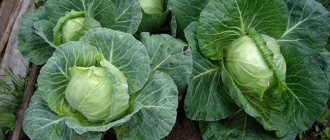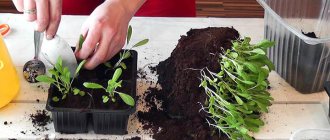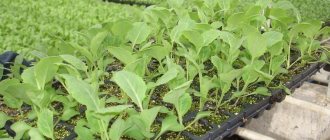Tomatoes are the most popular vegetable crop in our country.
Not a single garden or summer cottage is complete without beds with this plant. To grow your own vegetables, you have to plant seedlings. Otherwise, the vegetables do not have time to ripen due to the too short Russian summer. Dear readers!
For you, we have created communities on social networks in which useful articles and interesting ideas are published several times a day! Subscribe and receive useful content in a convenient format! We will tell you in this article how to properly sow tomatoes for seedlings and what procedures seedlings need.
How to choose the right variety
The first thing you need to start with when sowing tomatoes is to choose the right variety of vegetables. The time when to sow grain depends on this.
The three main parameters that are important to focus on when choosing a variety are:
- Growing region. For northern regions, it is better to sow early-ripening tomatoes that will have time to ripen in a short period of warm weather. For the southern regions, virtually any variety can be sown.
- Places where you will plant tomatoes (garden or greenhouse). For a greenhouse, for example, indeterminate varieties are well suited.
- Harvest ripening period. Early ripening varieties ripen in 100 days, medium varieties ripen within 110 - 120 days, and late ripening varieties take up to 140 - 150 days.
ON A NOTE. Breeders develop varieties for different climatic regions. Plant the variety of tomatoes that suits you.
More information about tomato varieties is presented in our article “Tomato Varieties.”
Preparatory activities
When growing tomato seedlings at home, it is important to create optimal temperature, lighting and humidity. The composition of the soil in which the seeds will be planted is of great importance.
Sowing work begins with the acquisition of seeds, soil and preparation of equipment. There is never enough light to grow early seedlings. Therefore, it is worth taking care of additional lighting in advance.
Selecting a variety and purchasing seeds
Today there is a huge variety of varieties with different heights, growing seasons, variety of colors and fruit sizes. To choose seeds for sowing seedlings, be sure to read our rating of the best tomato varieties.
When purchasing seeds, preference should be given to reliable agricultural companies and breeders who have proven themselves to be the best. These can be websites of seed manufacturers or online garden stores.
Calculate your capabilities, how many seeds you will need for sowing and how many seedlings you can plant in your garden or greenhouse. The number of seeds is indicated on each bag. Also check the stated expiration date.
Experienced gardeners collect seeds from their gardens only if they are varietal tomatoes. It is not possible to obtain high-quality seeds from hybrids - they do not produce a harvest in the second generation.
Where to plant - containers for seedlings
You can use any convenient container as containers for growing tomato seedlings.
Wooden boxes are used to sow seeds in a schoolhouse . They are filled with prepared soil, and then the seeds are laid out. If the box is large, you can make several grooves and place seeds of several varieties in them.
Important! It is necessary to maintain the distance between seeds when sowing in large containers. Otherwise, the seedlings will stretch out and interfere with each other's growth.
For many years, gardeners have successfully used peat pots . They come in different sizes and are easy to choose for seedlings of any size. It should be noted that this is an environmentally friendly material that completely decomposes in the soil after planting.
How to properly prepare tomato seeds for planting?
After you decide on the variety, the grains need to be prepared for planting.
IMPORTANT! The preparation process is not necessary for pelleted, encrusted and plasma-coated seeds. These grains have already undergone pre-sowing preparation at the manufacturing plant.
Seed sorting
Unfortunately, not all planting material in the pack will be of high quality. Some of the grains are dummies. To weed out such planting material, sorting is carried out.
To do this, take half a glass of water and add 1 teaspoon of salt into it. Everything is mixed, and the grains are poured into the resulting salt solution. Some of them will float up - these are empty seeds that cannot be planted. Those that remain at the bottom can be safely planted.
The entire procedure takes 10-15 minutes. This is exactly how long it takes for good grains to float to the surface.
Do seeds need heat treatment or how to warm up tomato seeds?
The next step in the process of preparing planting material is heat treatment. It is needed to “wake up” the grains, which most of the time are stored in unheated warehouses or are in transit during transportation.
For heat treatment, it is enough to place the seed near the battery 20-25 days before sowing, but not on the radiator itself!
How to process planting material (etching)
The third step is etching, or disinfection. Tomatoes are a crop susceptible to fungal, viral and bacterial diseases. Carriers of infection can remain on the shells of the grains. There may also be nests of pest eggs invisible to the eye. To get rid of pathogens, the seed fund is treated with disinfecting compounds.
It is best to treat with Phytosporin (2 hours) or Chlorhexedine (30 minutes). The latter preparation does not even need to be mixed with water. A solution is prepared from Fitosporin - 1 drop per 100 ml.
The seeds are poured into a saucer and the active solution is poured there.
Do I need to soak tomato seeds and how to do it?
Next comes the soaking stage. During this procedure, the outer shell of the grains softens. If you add the drug to water, then in addition essential oils are destroyed, which slow down the development process.
You can soak it in regular warm water, or you can add growth stimulants: Epin, Zircon, aloe juice, Baikal-M, hydrogen peroxide.
If you are not a supporter of purchased products, then you can get by with hydrogen peroxide. A solution based on it will not only saturate the planting material with useful microelements, but will also destroy all pathogens.
More information about the use of peroxide can be found in our article Soaking seeds in hydrogen peroxide before planting.
What is sparging?
Sparging is an alternative to conventional soaking. The method is used to germinate the most difficult to germinate varieties.
The essence of the method is that the seeds are placed in water, which is constantly saturated with air bubbles. As a result, not only the hard shell of the grains softens, but also the essential oils that retard the development of seeds are washed out.
REFERENCE. After bubbling, seed germination occurs several days earlier. Some crops for 7-10 days!
For bubbling, you will need a compressor (for example, an aquarium compressor), which will saturate the water with oxygen.
The algorithm itself is simple: fill a container with water at room temperature, place the planting material there and lower the compressor tube. Tomatoes are bubbling at intervals of 16-18 hours.
How to harden seeds
Hardening is the last step in preparing planting material. At this stage, viruses and bacteria finally die.
The essence of the method is to expose the grains to cold and heat at certain intervals.
The most affordable way is hardening in the refrigerator.
After soaking, transfer the seeds to a damp, clean cloth and then to a container. The box is then placed in the bottom drawer of the refrigerator overnight. They take everything out in the morning and keep it warm all day. Then put it back into the refrigerator overnight. This is repeated for 5 days.
Preparing tomato seeds
Seeds must be prepared before planting. To do this, certain procedures are carried out.
Sorting
For planting, you should use only high-quality seeds. To select good ones, they are kept for 15 minutes in a salt solution (30g of salt per 1 liter). Those seeds that float to the surface are empty and should be thrown away. Those that are at the bottom are suitable for sowing.
Disinfection
Tomato seeds are disinfected using one of the proposed solutions:
- 1 g of potassium permanganate is diluted in 100 ml of water.
- Phytosporin (1.5 g of the drug per 100 ml of water), soak the seeds for 2 hours.
- Dissolve 10 g of baking soda in 1 liter of water. Leave the seeds in the soda solution for 12-24 hours.
- Aloe juice is diluted with water in a ratio of 1:1. The seeds are kept in the solution for 24 hours.
Boric acid solution (optional)
Necessary for feeding seeds and destroying pathogenic bacteria. 1 g of the substance is diluted in 1 liter of water. The seeds are kept for a day.
Growth stimulant
Sodium Humate, Epin, Potassium Humate or Epin are suitable. It is diluted in melt water and the seeds are treated for 12 hours.
Epin-Extra or Zircon: 1-2 drops of the product are dissolved in 100 ml of water. Seeds in gauze are immersed in a solution at a temperature of +20C for 12-20 hours.
Hardening (not required)
For hardening, soaked seeds are left in the refrigerator for 24 hours. This treatment makes the seedlings strong and resistant to unfavorable growing conditions.
Care
After refrigeration, the seed is laid out between layers of a damp cloth on a saucer. The cloth should be regularly moistened with warm water. The seeds will hatch in 4-5 days, then they can be sown.
Suitable dates for planting
When planting tomatoes, it is important to focus on the climate of the region. In warm areas, plant earlier. For example, tomatoes for a greenhouse are sown at the beginning of February, and for open-air they are planted closer to February 10th.
In colder regions, plant in spring. For example, in the Urals, Far East and Siberia, tomatoes for greenhouses are planted at the end of March, and for gardens they are sown in early April.
In Central Russia they sow in mid-March.
ON A NOTE. The day to plant is determined based on the lunar calendar.
More information about when to sow tomatoes, as well as recommended planting dates for various regions, can be found in our article When to plant tomatoes for seedlings in 2022 according to the lunar calendar.
Suitable green manure plants
Green manures loosen the soil and saturate it with useful substances. Suitable options for tomatoes:
- leaf mustard (repels many pests, prevents the growth of weeds);
- phacelia (neutralizes high acidity of the soil, attracts beneficial insects);
- oilseed radish (deeply loosens the soil);
- lupine (saturates the substrate with nitrogen, “pulls” nutrients closer to the soil surface);
- vetch (saturates with nitrogen, the green mass is used as a natural fertilizer).
Green manure for tomatoes can be planted in spring (to loosen the soil), autumn (using greens as a natural fertilizer) and during the summer (to protect against weeds, pests and attract beneficial insects)
How to choose the right soil
Next, we select the right soil for growing.
The most affordable is universal soil for seedlings. It is a light nutrient medium and is great for planting tomatoes in.
Experienced summer residents can prepare the substrate themselves. To do this you will need humus, peat and river sand in a ratio of 2:2:1. The soil is disinfected (with potassium permanganate or by calcination in the oven).
REFERENCE. No need to add soil from the garden. With it you can bring an infection and infect the seedlings.
Soil preparation and fertilizers
Before planting tomato seedlings, you need to carefully prepare the soil. The best soil for growing tomatoes is light loamy and cultivated sandy loam, protected from the north, well-warmed areas with increased relief. Prepare the soil in the fall:
- remove previous crops and weeds;
- carefully dig it up to a depth of thirty centimeters;
- apply organic fertilizers.
The amount of fertilizer depends on the fertility of the soil, usually from 5 to 10 kg/sq.m.
Humus is usually applied in the spring, before planting seedlings, and manure, compost and peat are applied during the fall season. If the soil is infertile, then organic fertilizers are required. If it is highly fertile, only mineral fertilizers are used in the recommended proportions or together with organic ones.
In early spring, the plowed land is harrowed and two pre-planting loosenings are carried out (one to a depth of 15 cm, the other to 10). In the second case, mineral fertilizers are applied: 20 grams of potassium chloride and 80 grams of superphosphate per square meter. Nitrogen fertilizers are applied in the form of fertilizing.
How to plant tomatoes for seedlings?
Now there are a great many options for where to plant tomatoes. You can sow in boxes, plastic and peat cups, peat tablets, special cassettes, etc.
Whatever option you choose, be sure to provide drainage. In the case of plastic boxes, for example, holes are made in the bottom and drainage material is placed on top.
Thanks to drainage, water does not stagnate in containers and rotting processes do not occur.
The main mistakes when growing tomatoes
This is mainly the sin of novice gardeners. They do not yet know many secrets, so the plant may not live up to their expectations. The most common mistakes:
- Seeds for seedlings are sown at the wrong time;
- Growing a variety intended for a greenhouse in the ground;
- The gardener purchased the seedlings already with flower stalks. This is fraught with slow rooting and fruit formation;
- Frequent watering;
- Overfeeding, especially with nitrogen: this affects the taste;
- Planting in the ground ahead of schedule: the seedlings freeze and die.
Germinating seeds in different ways, or how to plant seeds
Summer residents have come up with many ways of where and how to sow tomatoes. Let's look at the most popular ones.
Growing seeds in boxes
This is the most popular method of seedling cultivation. You will need plastic boxes (cake boxes, meat trays, etc.).
You make several holes in the bottom and lay a small layer of drainage (egg shells, fine expanded clay). After this, fill in the soil and moisten it.
Next, make several grooves 1.5 cm deep at a distance of 5 cm. Sow grains in them at a distance of 2 cm. Finally, sprinkle the sowing with soil.
Now the container should be covered with a transparent lid (glass, plastic, bag) and placed in a warm place. Ventilate the planting from time to time and add water as needed.
Growing tomato seedlings in peat tablets
This method requires peat tablets with a diameter of 4 cm and a box in which to place them.
First, place the tablets in containers and pour warm water inside each. It needs to be poured gradually. The tablets swell and increase in size. They become like a kind of glass.
Then plant 1-2 grains in the center of the tablet and sprinkle with soil. Next, we create greenhouse conditions and wait for shoots. Picking from peat tablets is carried out in the phase of 4 true leaves.
How to grow in cups
The advantage of growing in cups is that there is no need to pick. The procedure for sowing seeds is no different from growing in boxes: you make drainage holes, fill in the drainage and soil, make a hole and put a few grains in it.
You sow in exactly the same way as for general planting: make drainage holes, fill in the drainage and soil, make a hole and put a few grains in it.
ON A NOTE. Until the seedlings hatch, the temperature should be about 25 degrees.
How to grow seedlings in a bottle?
Cut the plastic bottle in half. The half with the bottom will be the tray. Half with a neck - a pot.
First, we make a hole in the cork and insert a woolen thread there, which we tie behind the threaded neck. Next, we plant tomatoes in a makeshift pot. Here everything happens the same way as in the other methods described above.
When the first shoots appear, pour water into the pan so that the thread is in the water. This thread will carry moisture into the pot.
The method significantly saves time on watering.
Growing seedlings in diapers
You will need plastic packaging bags.
IMPORTANT! Packages must be new. You cannot use used ones!
Cut rectangles from bags. Place the substrate on the rectangle, stepping back a little from the edge. You don’t need to put a lot, because then the structure will need to be rolled up like a roll.
Next, sow the grains and lightly sprinkle with soil. Cover with the second rectangle and roll.
To prevent the entire structure from falling apart, it is secured with rubber bands for money.
The resulting rolls are placed in one container.
How to grow seedlings in a “snail”
This method is similar to the previous one, only the material used is not bags, but porous propylene or isolon. The roll is rolled out, soil is poured in and tomatoes are sown. Then they wrap it back and secure it with rubber bands.
Unlike diapers, you get low, thick rolls from which several seedlings sprout at once.
The method is suitable for limited space. You need to care for seedlings in the same way as with all other methods.
We sow in cassettes
Cassettes are an intermediate method of growing. It combines the advantages of the method when you plant in separate containers and the method when you sow in a common container.
We sow 2 grains into each section of the cassettes. As soon as they germinate, the seedlings must be thinned out.
This method is best used for early ripening tomato varieties that grow quickly.
We plant in tetra bags
When it's time to sow seeds, any container is used. Including halves of tetra-packs of juice or milk. They can be used as separate cups for planting seeds.
Sow in peat cups
This method is an improved version of peat tablets and plastic cups.
We plant in exactly the same way: 2-3 grains. When they germinate, we leave the strongest shoot and remove the rest.
Advantages: no need to dive, transplantation into open ground is carried out immediately with a glass.
The only downside is the high cost. Because in addition to the peat cup, grinding is necessary.
Are we putting it in toilet paper?
This technique doesn’t even require land. Your task is to make “rolls” from toilet paper and plastic bags.
Cut strips of garbage bags the width of a roll of toilet paper and a length of 1 m. Next, place toilet paper of the same length on the plastic tape.
We moisten one edge with water and plant seeds on it in 1 cm increments. Next, we roll it into a roll, grab it with an elastic band and place it in a glass of water with the seeds facing up.
When the shoots appear, we plant them in the ground.
BY THE WAY! You can use newspaper instead of toilet paper.
Sow in boiling water
This is not a complete method of sowing seeds, but rather a way to speed up the germination of grains.
Its essence is to shock the planting material if there is doubt about its quality.
We sow in the ground, but moisten it not with ordinary water, but with boiling water. The main thing is to immediately cover the entire structure with polyethylene.
As a result, the seeds are stimulated.
Planting in vermiculite
This is a soilless method of planting tomatoes. It is used when a summer resident deliberately refuses soil when growing tomatoes.
Washed vermiculite is poured into pots or containers. We plant seeds on top. Next, fill it with water and gradually add the hydroponic solution to it.
Containers for seedlings
To grow seedlings, various containers are used depending on the desires and capabilities of the gardener. The main thing is that they have drainage holes for water drainage. If there are no such holes, you can make them yourself or add a drainage layer of expanded clay or other natural materials to the bottom. To grow tomato seedlings you can use:
- Wooden or plastic boxes. They remain relevant today because they are easy to use. However, further plant picking is required.
Pros: You can transport seedlings in them. Such boxes are inexpensive and can be used for a long time, and you can make them yourself.
Disadvantages: such boxes with soil are very heavy and there is a possibility of damage to the root system during transplantation of seedlings.
- Plastic cassettes. These are cells of the same size fastened together. They can be of different widths and lengths. Most often, a tray for collecting water must be purchased separately or invented using improvised means.
Pros: They are lightweight, easy to use, and have drainage holes. They can be cut with scissors. Seedlings from such cassettes are easily removed
Cons: short service life, difficulties during transportation.
- Peat cups. Very popular among gardeners. Made from environmentally friendly materials. Experts recommend using peat cups when picking. Pros: environmentally friendly, durable. There is no need to replant plants; peat dissolves in the soil, acting as an additional fertilizer for plants.
Cons: moisture evaporates quickly, so you need to water more often.
- Peat tablets. This is compressed peat in a mesh with added nutrients. Before use, it must be soaked in water for swelling.
Pros: easy to use, quickly dissolve in the soil, stimulate the development of the root system.
Cons: expensive, requires an additional tray, moisture evaporates quickly.
- Plastic cups. They are the ones most often used by gardeners for sowing tomato seeds for seedlings . Use 100 and 200 ml cups for sowing seeds and 500 ml for picking them.
Pros: easy to use, the seedling is easy to remove from the cup along with a lump of earth when transplanting, long service life.
Cons: no drainage holes, an additional pallet is required, transportation is difficult.
What is the Chinese method of growing tomato seedlings?
When using this method, it is necessary to sow 25-30 days earlier than required.
IMPORTANT! This method can only be used for growing hybrids and indeterminate varieties.
The seedlings are cared for as usual. When the plant grows to 20 cm, pruning is done under the cotyledon leaves. Next, the cuttings are rooted in a new container, after soaking for 10 minutes in a solution of a root formation stimulator. Then the seedlings are removed to a dark place for 3 days.
IMPORTANT! The method is suitable only for experienced summer residents. At best, ¾ of the seedlings survive.
Care at home
Watering
Water once a week along the edge of the box from a watering can without a nozzle very slowly. Every day the air around the seedlings is sprayed with a spray bottle to maintain the required air humidity. In hot weather, spray 2 times a day. It is better to avoid getting water on the seedlings.
Lighting
Young tomatoes require intense lighting, up to 16 hours a day, and at the final stage of growing seedlings, 10 hours is enough. Therefore, the seedling boxes are placed on the windowsill of the south window, and in the evening the phytolamps are turned on over the seedlings. The boxes must be rotated regularly so that the seedlings do not bend to one side.
Pickirovka
At first, the seedlings grow in a crowd, but later the seedlings begin to interfere with each other. To do this, they are picked 12-14 days after sowing. By this time, 1-2 true leaves should appear.
During picking, seedlings are buried 4 cm into the ground. They are planted in a common box according to a pattern of 10x10 cm.
Top dressing
Tomato seedlings take about 60 days to grow. At this time, plants quickly absorb all nutrients from the soil. Therefore, you will need to feed her a couple of times. Fertilizers are applied after watering at the roots in the form of organic matter or complex mineral fertilizers.
For example, use the following feeding option:
1 tbsp. l. superphosphate, pour 5 liters of water, add 1 tbsp. l. potassium sulfate. The seedlings are first watered and then fertilized at the rate of 2 tbsp. l. for 1 root.
Hardening
Seedlings must be hardened off before transplanting into open ground in order to prepare them for more severe growing conditions. 10 days before planting, the seedlings are taken out onto the street or balcony. First for 30 minutes, gradually increasing the time to 12 hours a day.
By choosing the appropriate time for sowing tomato seeds for seedlings, you can grow healthy bushes that will give a good harvest. Of course, it is also important to prepare the soil and seeds, as well as properly care for the seedlings. In addition, it is important to choose the right time to transplant seedlings to a permanent location.
Watch the video! Sowing tomatoes for seedlings. Dates and methods of sowing
Planting tomato seedlings in a greenhouse
If you have a heated greenhouse, then seedlings can be planted directly in it. You can also build a greenhouse yourself.
The technology for growing in a greenhouse is no different from the traditional seedling method, but you need to be more careful in preparing the soil. It is necessary to add sifted river sand to the ground for better drainage, and then disinfect the substrate by treating it with a solution of Fitosporin or potassium permanganate.
IMPORTANT! Do not forget to ventilate the greenhouse to prevent fungal and bacterial infections.
How to care for seedlings
The optimal germination temperature for tomato seeds is considered to be +23–25°C . Also, after planting the seeds, maintain high humidity.
Until the moment of germination, that is, until the first shoots appear, the crops must be periodically ventilated and watered when the top layer dries out. After airing for 20 minutes, wipe off excess water from the glass or bag and only then cover it again.
How long does it take for seeds to germinate?
Properly prepared seeds germinate within 5-7 days .
If tomato seeds do not germinate for a long time, the following problems or mistakes by gardeners are possible:
- low-quality seed material: the expiration date of the seeds has expired (6-7 years) or their storage conditions have been violated (temperature no higher than 19 degrees);
- the preparatory work was carried out incorrectly (soaking and disinfection of seeds);
- the seeds were planted too deeply in the ground; The optimal planting depth for tomato seeds is 6-10 mm.
- unsuitable conditions for seed germination - too cold a temperature or inappropriate humidity (the soil is too dry or overwatered and the seeds rot).
After the first shoots, the covering material is not removed immediately, but gradually. At first it may be 2-3 hours during the day, and at night - shelter. Within 3–5 days the structure can be completely disassembled.
Subsequent care of seedlings
For proper development of tomato seedlings, it is necessary to create optimal conditions. One of the most important is lighting.
Seedlings need 12–15 hours of full light . The best place for seedlings are windows facing south or southwest. If there is a lack of light, you will have to add additional lighting, especially on cloudy days.
To prevent tomato seedlings from stretching out, in the first days, as soon as the first seeds hatch, the temperature is lowered to +14–16 °C. The duration of such a temperature of 7 days will be quite sufficient. After a week, the temperature can be raised again to +20–22 °C during the daytime and +16–18 °C at night. Then the seedlings will turn out thick, low and strong.
Young seedlings should be watered only with warm, settled water. It is better to spray from a spray bottle after drying the top layer of soil.
Planting seedlings in the ground
By the time of planting in a greenhouse or open ground, the seedlings should have a height of 25-35 cm and 8-12 developed leaves . There should not be more than 1 formed inflorescence on it.
Early varieties of tomatoes are planted in the ground when the seedlings are 40-50 days old. Mid-season - 50-60 days. And late and large-fruited varieties 60-70 days after the first shoots.
Conditions required for tomato seedlings and care features
A week after you sow the seeds, the tomatoes will sprout. Now they need to provide appropriate conditions.
Temperature
After germination, the containers should be moved to a cooler place. The approximate temperature is 18 degrees. After a few days, the temperature can be raised to room temperature and maintained until planting.
Lighting
This is the most important factor. Plants need ultraviolet light to grow and develop. If there is not enough of it, the seedlings will “stretch out,” that is, the stems will become thin and the plants themselves will become weak.
To prevent this from happening, provide the seedlings with 12 hours of daylight. If necessary, purchase phytolamps. They are available in hardware stores.
Harvesting
Tomatoes are harvested based on ripening time, variety, climate zone and other indicators. But there are general rules for collecting fruits:
- if the tomatoes are intended for long-term storage, pick them with the stalk; if for eating, preparing salads or clogging, leave the stalk on the branch;
- harvest daily, as tomatoes ripen unevenly;
- It is better to remove fruits early in the morning or in the evening.
Tomatoes tend to ripen after they are picked, so if you want to preserve the crop for a long time, pick the fruits when they are not ripe. If you put them in a dark and cool place, ripening will be delayed, if in a warm and light place, they will turn red in 2-4 days.
If the planting of tomato seedlings is carried out correctly, and subsequently the standards for caring for the bushes are followed, you will receive a bountiful harvest of large tomatoes. The main thing is not to forget about all the rules, apply fertilizers in a timely manner, carry out preventive spraying and harvest on time.
When to plant tomato seedlings
Picking should be done when the second pair of leaves appears.
ON A NOTE. The first pair are cotyledon leaves, the second pair are true leaves.
Picking is done if you planted tomatoes in common boxes. After picking, the tomatoes should be fed.
Detailed information about picking is presented in the article Picking tomato seedlings.
Organic fertilizers for tomatoes
To increase the ovary on plants, spray the bushes with a solution of boric acid, one sachet (10 g) per bucket of water. This should be done when the second flower cluster appears, and repeat after a week.
Tomatoes need to be fed throughout the summer. They respond well to watering with herbal infusion, whey solution - a liter of whey per bucket of water.
Contributes to obtaining a good harvest “mash” - a fertilizer made from yeast and sugar. Dilute a packet of dry yeast and a glass of sugar in three liters of warm water. Ferment for three days, then use. Dilute 100 g in a bucket of water and do root watering. To enhance the effect, mulch the tomato bushes after watering.
Fertilizer made from yeast and sugar
Features of watering
Plants should be watered ONLY with warm and settled water. While the plants are still small, use drip irrigation. You can use the same syringe or syringe without a needle. When the seedlings grow, you can water them from a watering can or mug.
It is very important not to overwater the plantings to avoid rotting. It is necessary to moisten the soil as it dries.
IMPORTANT! Do not waterlog containers with tomatoes, but do not let the soil dry out!
Soil preparation
The seedlings will grow well and become strong and healthy if the seeds were planted in fertile, nutritious soil. You can purchase it at a garden store or prepare it yourself using one of the following recipes.
Recipe 1
You need to mix the following ingredients in equal proportions:
- Sand.
- Compost or humus.
- Garden land.
- Peat.
Next, to reduce the acidity of the soil, add 40 g of dolomite flour to a bucket of soil mixture. You can use wood ash instead of flour.
It is also recommended to add to the soil:
- 10 g potash fertilizer.
- 30 g superphosphate.
- 10 g urea.
Instead of these elements, you can add a complex fertilizer containing potassium and phosphorus. In addition, this fertilizer contains a small amount of nitrogen.
Recipe 2
To prepare the soil according to the second recipe, you need to mix:
- 2 parts humus or compost;
- 1 part turf soil;
- 1 part of high-moor peat;
- 1 part coarse river sand or sphagnum moss.
Add 1 cup of wood ash to a bucket of this soil mixture.
Advice! Instead of sand or moss, perlite can be used to loosen the soil.
How to feed tomato seedlings
Tomatoes do not need too frequent fertilizing. 2-3 will be enough for the entire growing period.
Typically, fertilizers are added after picking and again after another 10-15 days. It is better to use complex mineral fertilizers. In this case, the saturation of plants with all necessary elements is guaranteed.
All the nuances and tricks of feeding tomatoes are described in detail in the article “How to feed tomato seedlings.”
Landing at a permanent place
In order for tomatoes to produce a good harvest and not get sick, it is necessary to observe crop rotation. The best predecessors for them will be root vegetables (excluding potatoes), all types of cabbage, and perennial herbs.
The soil should be neutral or slightly acidic. Light and fertile soil contributes to earlier harvesting.
Tomatoes are planted in open ground after the threat of frost has disappeared; the seedlings must first be hardened.
At first, it is recommended to cover the plants with film or agricultural material to protect them from the cold.
Drop off rules:
- Most often, tomatoes are planted in two rows with an interval between plants of 25-30 cm.
- Row spacing should be 50-65 cm wide.
- Seedlings should not be buried more than 4-5 cm compared to the initial planting.
- Overgrown seedlings are planted obliquely, with their crowns facing north.
After planting, make sure that a hard crust does not form; the soil is regularly loosened after watering.
In open ground
15-20 days after planting, the tomatoes need to be hilled; in the future, this procedure is carried out twice more. Simultaneously with hilling, mineral fertilizers are applied. Their deficiency can be identified by the appearance of the plants.
Tomatoes do not like irrigation by sprinkling; moisture is applied strictly at the root. The culture requires rare but abundant watering. You can determine the need for moisture by the appearance of the tomatoes - the leaves darken and become drooping.
On a note! With excess moisture, gray rot and late blight can develop; insufficient watering can provoke the appearance of blossom end rot.
For the first 10-15 days after planting the seedlings, tomatoes do not need to be watered; the moisture added during planting will be enough for them. With the appearance of ovaries, the need for water in tomatoes increases sharply. At this time, the plants are watered at intervals of 5-7 days, adding up to 5 liters of water under each bush.
To retain moisture in the soil during the fruiting period, mulching is used. When low-growing tomatoes begin to yield, watering is reduced. With determinate varieties, the opposite is done, giving them more water during this period.
Tomatoes can be formed into one, two or three stems.
- All stepsons are removed, not allowing them to grow more than 5 cm in length.
- This procedure must be performed in the morning on a sunny day so that the wounds heal before evening.
- Stepchildren should not be torn off by hand, so as not to damage the stem. Typically, sharp pruning shears or small scissors are used.
Standard forms do not need to be formed.
For preventive purposes, bushes are sprayed two or three times a season with Bordeaux mixture or a solution of any copper-containing preparation. The need for this measure increases after the rainy period.
How to harden tomato seedlings?
Towards the end of May, depending on the region, it is necessary to harden the tomatoes. This procedure will allow the tomatoes to better adapt to their new conditions.
You can start by placing boxes with seedlings on the balcony, veranda or porch for 1 hour. The next day the time is increased. And so, day after day, as the weather permits, the period of stay in the fresh air increases.
Ideally, seedlings should stay outside for a whole day. But often gardeners plant plants after a week of hardening.
Predecessors
If you grow tomatoes on the bottom for 3 years, then the yield will subsequently drop by fifty percent, due to the fact that the same elements of mineral nutrition are removed from the soil and due to the massive damage to plants by pests and diseases that are increasingly developing in the soil . Excellent precursors for tomatoes are:
- legumes (except beans);
- carrot;
- onion;
- cabbage;
- cucumber.
It is forbidden to plant tomatoes after nightshade crops (potatoes, eggplants, peppers).
You can plant after these vegetables.
You can return to the same place after four years.
How to determine the time of transplantation into open ground
The gardener’s task when growing seedlings is to ensure that the seedlings are ready for planting by the time the weather finally becomes good outside (18-20 degrees Celsius during the day and 15 at night).
Plants should already have a strong stem, grow to 25-30 cm in height and have at least one bud.
By region, transfer times are approximately as follows:
- South – end of April,
- Volga region - end of May,
- Central Russia – end of May – beginning of June,
- Ural, Siberia, Far East - first half of June.
To the greenhouse
When grown in a greenhouse, plants need to be tied to a trellis a week after planting.
Greenhouse tomatoes must be shaped.
- Indeterminate varieties are pinched above the 5th brush, leaving two leaves on top.
- Determinate varieties are formed in such a way that there are 4-5 brushes left on the bush.
The lower yellowed leaves are periodically torn off. Watering is carried out in the first half of the day, after which the greenhouse is ventilated.
Root dressings are applied three times per season. As a top dressing, you can use mineral complexes, liquid organic fertilizers, and an infusion of mowed grass.
For more successful pollination, the bushes are shaken during flowering.
Common mistakes
When growing seedlings, the following mistakes are often made:
- The wrong variety of tomatoes is selected. There is no need to rely on beautiful descriptions on a packet of seeds or the manufacturer’s website. Use varieties that are suitable for your region.
- A summer resident plants unprepared seeds . Disinfection, bubbling, and soaking are important procedures that help the summer resident get healthy seedlings. There is no need to ignore them.
- Failure to comply with care rules. The two most common mistakes with this plan are overwatering and not enough light. As a result, the plants either begin to rot or stretch out.
- No picking. Plants need space to grow. Therefore, tomatoes from a common box to a specific one must be planted in separate containers.
- No hardening. Over the months spent at home, the seedlings get used to the mild indoor climate and regular care. If you plant them in open ground without hardening off, many plants will not tolerate such stress and will die. To prevent this from happening a few days before transplanting, harden the seedlings.
Sowing rules
All gardeners grow tomatoes on their plots, as they are one of the main vegetables on our tables. However, in order to grow tasty vegetables, you must adhere to all the rules for sowing seeds and caring for seedlings.
- First you need to decide on the sowing time.
- Properly prepare the soil and disinfect it.
- Select the necessary containers for sowing seeds and further picking them.
- Process the seed and germinate it.
- Sow the seeds to the required depth and send the containers with the seeds to a warm place for germination.
Answers to frequently asked questions
Below are answers to the most frequently asked questions regarding growing tomatoes from seedlings.
Which growing method should I choose?
If you don’t have enough experience yet, it’s best to sow tomatoes directly into peat cups. This way you won’t have to pick, and planting in open ground can be done without taking the seedling out of the container.
If you already have some experience, then grow in the traditional way: first sow in boxes, then plant in plastic cups, then plant in a permanent place.
How to choose the right variety of tomatoes?
Focus, first of all, on the climate of your region. In regions with a harsher climate, you should not sow late-ripening varieties. With a high degree of probability, the tomatoes simply will not have time to ripen.
Is it necessary to soak the seeds?
If you buy coated seeds, then no. In other cases, soaking will be a useful procedure that will significantly speed up the germination period. In addition, during soaking, the sprouts will be saturated with a growth stimulant, and the planting material will be disinfected.
Why do seedlings stretch?
They miss the sun. Boxes with plants need to be regrouped. If you have problems with access to sunlight, use phytolamps.
What to do if the seedlings don't grow?
Assess conditions and care. Do the seedlings have enough light? Are you watering them enough? Is the indoor air too dry? All of the above factors negatively affect the growth and development of seedlings.
I have a few packets of seeds left from last year, can I use them?
Examine the packaging; if the expiration date has not yet passed, then you can sow. If the packaging is not preserved, sort it. Pay more attention to these seeds: be sure to soak or bubble them. But it’s still better not to use old copies. Beans 1-2 years old germinate best.
What is the best way to feed?
It is generally accepted to feed with mineral fertilizers. Seedlings do not really like organic matter. Use harmless drugs: Gumi, Agricola, Energen. Among home remedies, ammonia and aloe juice are the most effective.
Subtleties of pruning tomatoes
Tomato is a bright representative of vegetable crops in our region. Open ground, under the scorching sun, is the main place for growing vegetables. Due to the abundance of sun, the green part of the plant grows, which must be systematically pruned.
Several reasons why you should prune tomatoes.
- Different varieties of tomatoes germinate differently. Some varieties are famous for their large leaves that can block the sun's rays. As a result, the other bush will no longer receive proper sunlight and will not produce the desired harvest.
- It is also worth remembering that planting tomatoes in the ground exposes them to the risk of contracting diseases. Those who have encountered this know that more microbes form in the shade, and due to increased moisture they develop faster.
- Excessive green mass negatively affects the fertility of tomatoes. Vegetable crops spend a lot of energy on maintaining leaves and shoots, rather than forming fruits.
After you have planted tomatoes in the ground, pruning is carried out a couple of times a week. Immediately trim off foliage that touches the ground. The procedure is necessary for a number of reasons:
- when watering plants there is a risk of infection with leaf mold;
- increasing the amount of sunlight hitting the base of the stem promotes growth.
Remove shoots growing towards an adjacent bush. When pruning, the tomato variety plays a significant role. On determinate varieties, 5 stepsons are left, the rest are cut off, and for non-seedling tomatoes - 2-3.
When the fruits ripen, you will need to trim off all the greenery below the fruits of the plant. The final trimming touches include removing the top. Of the total quantity, it is necessary to leave only one ovary with 5-6 leaves, and purposefully cut off the rest. This promotes fruit growth and saturation.
Pruning is a measure to prevent plant diseases and also helps to increase yield. Remember that more does not always mean better.
Complete instructions for growing tomatoes in open ground
The productivity of tomatoes is affected by regular watering, periodic fertilizing with organic fertilizers and pinching. After pruning side shoots, the bush and fruits form and develop correctly.
Before planting tomatoes, you should make sure that the shoots need to be removed.
Untimely removal of stepchildren leads to the following consequences:
- decrease in yield;
- increase in ripening period;
- reduction in fruit weight;
- thickening of plantings, spread of diseases;
- breaking off branches under the abundance of fruits.
The procedure is carried out on an adult plant that has entered into force. The algorithm for forming a bush depends on the variety of tomatoes, the speed of ripening and the climatic characteristics of the region. The emphasis is either on the quantity of the harvest or on the quality of the fruit. For open ground, it is preferable to grow in 2–3 stems, for a greenhouse - in 1.
The rules for pinching depend on the type of tomatoes. In determinate varieties, growth stops on its own - these are low-growing plants. On a bush of this type, 2–3 additional stems are left, that is, the stepsons located close to the top are not removed. Indeterminate varieties grow unhindered and can sometimes reach 2 meters in height. Side shoots of this variety will have to be pinched off throughout the season, leaving only one stem.
How else to determine which variety is determinate or indeterminate - pay attention to what is written on the bag of seeds, this is sometimes noted there. A determinate variety is often called “non-sapling”. And they are misleading by this, since this does not mean that the variety does not have stepsons.
How to distinguish a stepson from a peduncle? There are always leaves on side shoots, even at the very beginning of its growth. There are no leaves on the peduncle at all.
Rules for planting tomatoes when growing them in open ground:
- time: morning hours are chosen for the procedure - there is less chance of infection through the wound;
- length of sprouts: shoots 2–3 cm in length are removed, the long shoot is pinched from above; instruments: actions are carried out with fingers or scissors, the instrument requires disinfection;
- safety: use gloves;
- accuracy: do not throw the shoots on the ground next to the bush.
The shoots are partially removed; it is recommended to keep the stumps 1–2 cm thick. For tall varieties, 3–4 leaves are left under the break point.
Newly bred super-determinate varieties and hybrids do not require pinching. In these species, a programmed number of ovaries are formed, after which growth stops. In Russia, determinate types of tomatoes are predominantly used. Regular pinching increases the yield or quality of the fruit.











